Medium Tank M3 was doomed.
 Bashny.Net
Bashny.Net
Medium Tank M3 "General Lee" / "General Grant»
via armor.kiev.ua/Tanks
20 photos and text

2 ...
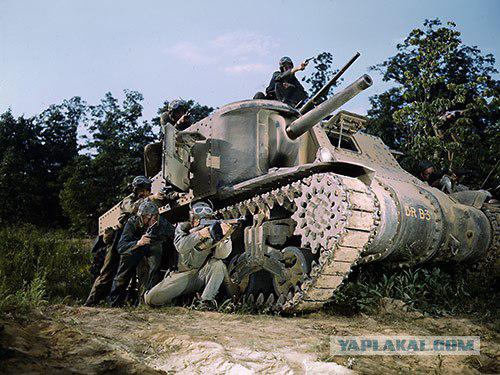
3 ...

4 ...

5 ...

6 ...
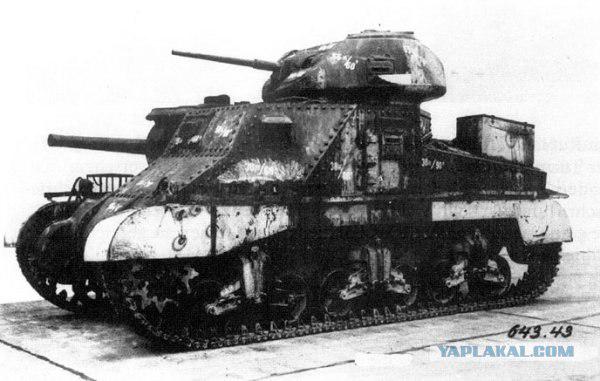
7 ...

8 ...
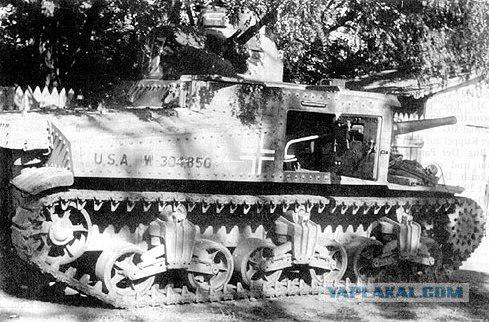
9 ...

10 ...
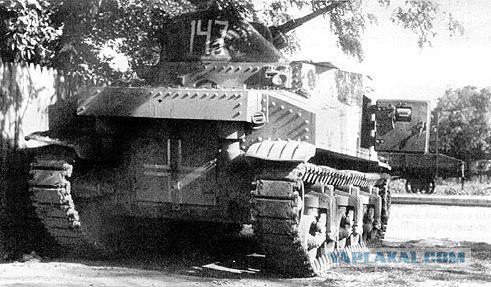
11 ...
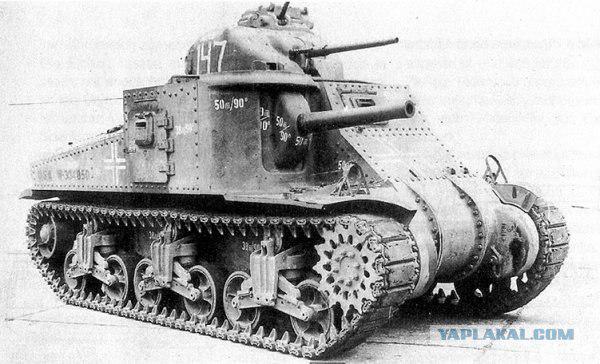
12 ...

13 ...
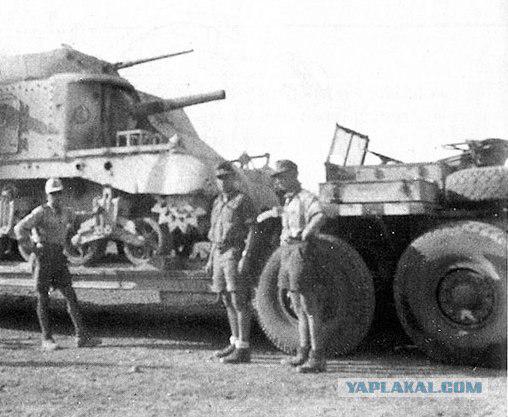
14 ...
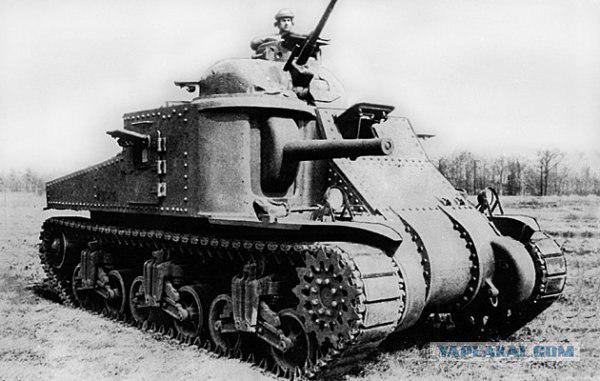
15 ...

16 ...
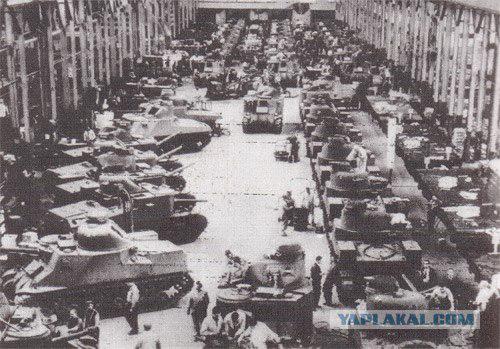
17 ...

18 ...
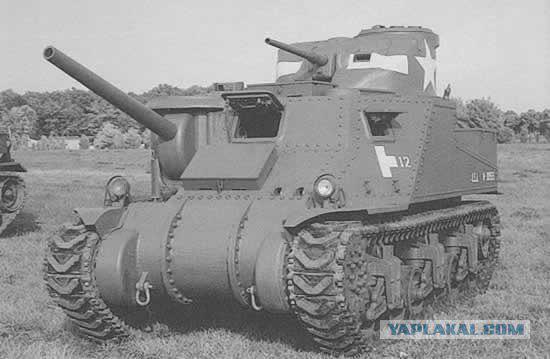
19 ...

20 ...

Medium Tank M3 General Grant
In mid-1940, American industry has received an order from the command of M3 - a new sample with a reinforced armor weapons and book, is the development of small series M2. As previously installed in the tower comparatively overall 75mm guns was not placed in its housing. So there was a tank "M3", the first copy of which appeared in January 1941. Chassis M2 saved. The design used the homogeneous armor plates that were fastened with rivets. Feature of "M3" was a three-tier arrangement of arms. In the tower with a 37-mm cannon and coaxial machine gun, Polycom and rotating hydraulic drive for the traverse, placed three tanker. The commander's cupola machine gun set with limited vertical angles pickup. For the first time in an American tank building used 75-mm cannon destined for combat armored and other security purposes.
M3 Otro several factories, with petrol engines of various brands. This complicated repairs and maintenance, training of tank crews and technical staff. It was unsuccessful, and the shape of the case: tank was too high, bulky. Vertical armor plates were poor protection. Patency was low, repair in the field difficult. All of these disadvantages have been known since the beginning of production, but for lack of a better M3 yet been put into a series.
"M3 General Grant» produced from April 1941 to December 1942 in six models: M3, M3A1, M3A2, M3A3, M3A4, M3A5. There were produced 6258 machines differ in the type of engine and method of manufacturing the casing. Modifications A2 and A3 obtained welded housing on M3A4 and A5 returned to the rivets. We used radial aircraft engines and gasoline-line engines. In the latter case, it was necessary to lengthen the body, leading to an increase in weight of up to 29 m.
For the first time in combat "M3 General Grant» was attended by 26 May 1942 as part of the British Army at El Ghazala in North Africa. They were better armed and armored than German and especially Italian tanks. But the emergence of modernized Pz.IVF German tanks with long-barreled 75-mm cannon to eliminate this advantage.
Lend-Lease to the USSR was delivered about 1400 "M3". Generally, in the Soviet Union tanks M3 greeted without enthusiasm. By mid-1942, his armor is not saved from the German tank guns. It was necessary speed, stealth and maneuverability. Awesome silhouette of a tank on Russian roads had poor permeability, a low-power motor, also very sensitive to fuel and oil, M3 did not cause enthusiasm among Soviet tank.
The biggest drawback M3 «General Grant» - rubber tracks. During combat, tires burnt out and collapsed caterpillar. Tank became a stationary target. M3 Soviet tankers dubbed "mass grave for six." An example is the report of the commander of the 134th tank regiment Tikhonchuk of December 14, 1942 .: "The American tanks in the sands run extremely bad, constantly fall off the tracks, get stuck in the sand, losing power, due to which the rate is extremely small.
Performance characteristics:
Crew: 6 persons;
Engine: «Continental» R-975-EC2;
armed 75-mm cannon in the body; 37-mm gun in the turret; 3 7 gun, 62 mm. TTH:
The combat weight of 27 tons 9
Layout scheme of separation of management front, rear engine
The crew of 6-7 people.
6258 Number of issued pieces
Dimensions
Body Length 5639 mm
Housing width 2718 mm
Height 3124 mm
Ground clearance 432 mm
Reservations
Type steel homogeneous armor
The forehead of the body (top) 51 / 30-38 / 53 mm / deg.
The forehead of the body (bottom) 51 / 0-45 mm / deg.
Hull sides (top) 38/0 mm / deg.
The board of the housing (bottom) 38/0 mm / deg.
Feed housing (top) 38 / 0-10 mm / deg.
The bottom of 13-25 mm
The roof of the body 13-22 / 83-90 mm
Forehead tower 51/47 mm / deg.
Bort tower 51/5 mm / deg.
Forage tower 51/5 mm / deg.
Armament
The caliber and brand of 75-mm gun M2 or M3 and 37 mm M5 or M6
Barrel length 28, 5 (for M2) or 37, 5 (for M3), 53, 1 (for M5) or 56, 5 (for M6) caliber
Ammunition gun 50 × 75 mm, 178 × 37 mm
Angles BH -9 ... + 20 ° (to 75 mm) -7 ... +60 ° (to 37 mm) hail.
GN angles of ± 15 ° degrees.
Sights M1, M2
3 × 7 machine guns, 62-mm M1919A4
Ammunition guns
9200 Mobility
Engine Type 9-cylinder radial air-cooled carburetor
Engine Model "Continental» R 975 EC2
Engine output 340 hp
Cruising on the highway 193 km
Suspension spring pairs blocked
Track width 421 mm
Road speed of 39 km / h
Houde. ground pressure 0, 88 kg / cm2
To overcome the wall of 0, 6 m
The width of the ditch surmounted 2, 25 m
Fording 1 0 m
Description:
By design, the tank is a machine, the First World War, with the location of the onboard instruments sponson, as British tanks Mk I, Mk VIII, but instead of cutting fixed - rotating tower. The engine was located behind, transmission - front, gearbox - a rotary floor of the tower. Between them - fighting compartment. The engine is mated to the transmission driveshaft. Under the shaft were thrust engine management. All of it was closing removable cover. The thickness of the armor was unchanged on all models, and were as follows: two inches (51mm) - frontal armor, and a half-inch (38mm) - board and feed sheets one-half inch (12, 7 mm) - the roof of the enclosure. The bottom had a variable thickness ranging from half an inch (12 7mm) under the engine to one inch (25, 4 mm) in the area of the fighting compartment. The walls of the tower were armor - two and a quarter inches (57mm), and the roof - seven-eighths of an inch (22mm). The front plate was mounted at an angle of 60 degrees to the horizontal, side and rear - vertically. Armour plates fastened with rivets (modified MH, MZA4, MZA5) or welding (modification and MZA2 MZAZ) to the inner frame. The tank turned a spacious fighting compartment, and, until now, considered to be one of the most comfortable. From within the papered sponge rubber casing to protect the crew from small fragments of armor. The sides of the doors installed, the hatches were on top in the machine-gun turret. This ensures fast planting crew, and most importantly - convenient to evacuate the wounded from the tank through a side door, but the door was lowered and the strength of the body. Each crew member had peepholes and loopholes for firing of personal weapons, armor protected by canopies. Tank MOH had enough strong arms. Home fire force - 75 mm gun mounted in the sponson. This weapon was designed in the arsenal Vesterfleyt based on the French 75 mm field gun Puteaux and Dupont, sample 1897, adopted by the US Army after the First World War. 37-mm gun was set up in the same arsenal in 1938. On the M3 tank installed its modification M5 or M6 in a 360-degree rotating turret. The tank is equipped with four machine guns «Browning» caliber of 0, 30-inch (7 62 mm) of the sample in 1919, applied on the tanks in the First World War.
Commercially available from June 1941 to December 1942. In total, in different versions, it was released 6258 M3. About 2/3 of the issued M3 have been transferred to other countries, almost exclusively the United Kingdom and the Soviet Union, under the program Lend-liza.Ot Soviet tank was nicknamed "mass grave for six." In addition, until sufficient quantities of improved medium tank M4 «Sherman», M3 was the main medium tank USA. M3 actively used in battles in 1942-1943, mainly in North Africa. By 1944, he was almost universally replaced in parts "Sherman," but a small number of "grant" was used in 1944 in South-East Asia. On the chassis M3 is also produced in large amounts of ACS and other specialized machinery.
Modifications to the tank M3 General Lee:
M3A1 (English designation Lee II).
The first modification of the tank M3A1 (English designation Lee II) had a streamlined body and a cast of 75-mm gun M2, with a shortened barrel and a counterweight at the muzzle. Other characteristics consistent with the basic model. The tanks were manufactured «American Locomotive company» from February to August 1942. A total of 300 cars produced.
Source:
via armor.kiev.ua/Tanks
20 photos and text

2 ...

3 ...

4 ...

5 ...

6 ...

7 ...

8 ...

9 ...

10 ...

11 ...

12 ...

13 ...

14 ...

15 ...

16 ...

17 ...

18 ...

19 ...

20 ...

Medium Tank M3 General Grant
In mid-1940, American industry has received an order from the command of M3 - a new sample with a reinforced armor weapons and book, is the development of small series M2. As previously installed in the tower comparatively overall 75mm guns was not placed in its housing. So there was a tank "M3", the first copy of which appeared in January 1941. Chassis M2 saved. The design used the homogeneous armor plates that were fastened with rivets. Feature of "M3" was a three-tier arrangement of arms. In the tower with a 37-mm cannon and coaxial machine gun, Polycom and rotating hydraulic drive for the traverse, placed three tanker. The commander's cupola machine gun set with limited vertical angles pickup. For the first time in an American tank building used 75-mm cannon destined for combat armored and other security purposes.
M3 Otro several factories, with petrol engines of various brands. This complicated repairs and maintenance, training of tank crews and technical staff. It was unsuccessful, and the shape of the case: tank was too high, bulky. Vertical armor plates were poor protection. Patency was low, repair in the field difficult. All of these disadvantages have been known since the beginning of production, but for lack of a better M3 yet been put into a series.
"M3 General Grant» produced from April 1941 to December 1942 in six models: M3, M3A1, M3A2, M3A3, M3A4, M3A5. There were produced 6258 machines differ in the type of engine and method of manufacturing the casing. Modifications A2 and A3 obtained welded housing on M3A4 and A5 returned to the rivets. We used radial aircraft engines and gasoline-line engines. In the latter case, it was necessary to lengthen the body, leading to an increase in weight of up to 29 m.
For the first time in combat "M3 General Grant» was attended by 26 May 1942 as part of the British Army at El Ghazala in North Africa. They were better armed and armored than German and especially Italian tanks. But the emergence of modernized Pz.IVF German tanks with long-barreled 75-mm cannon to eliminate this advantage.
Lend-Lease to the USSR was delivered about 1400 "M3". Generally, in the Soviet Union tanks M3 greeted without enthusiasm. By mid-1942, his armor is not saved from the German tank guns. It was necessary speed, stealth and maneuverability. Awesome silhouette of a tank on Russian roads had poor permeability, a low-power motor, also very sensitive to fuel and oil, M3 did not cause enthusiasm among Soviet tank.
The biggest drawback M3 «General Grant» - rubber tracks. During combat, tires burnt out and collapsed caterpillar. Tank became a stationary target. M3 Soviet tankers dubbed "mass grave for six." An example is the report of the commander of the 134th tank regiment Tikhonchuk of December 14, 1942 .: "The American tanks in the sands run extremely bad, constantly fall off the tracks, get stuck in the sand, losing power, due to which the rate is extremely small.
Performance characteristics:
Crew: 6 persons;
Engine: «Continental» R-975-EC2;
armed 75-mm cannon in the body; 37-mm gun in the turret; 3 7 gun, 62 mm. TTH:
The combat weight of 27 tons 9
Layout scheme of separation of management front, rear engine
The crew of 6-7 people.
6258 Number of issued pieces
Dimensions
Body Length 5639 mm
Housing width 2718 mm
Height 3124 mm
Ground clearance 432 mm
Reservations
Type steel homogeneous armor
The forehead of the body (top) 51 / 30-38 / 53 mm / deg.
The forehead of the body (bottom) 51 / 0-45 mm / deg.
Hull sides (top) 38/0 mm / deg.
The board of the housing (bottom) 38/0 mm / deg.
Feed housing (top) 38 / 0-10 mm / deg.
The bottom of 13-25 mm
The roof of the body 13-22 / 83-90 mm
Forehead tower 51/47 mm / deg.
Bort tower 51/5 mm / deg.
Forage tower 51/5 mm / deg.
Armament
The caliber and brand of 75-mm gun M2 or M3 and 37 mm M5 or M6
Barrel length 28, 5 (for M2) or 37, 5 (for M3), 53, 1 (for M5) or 56, 5 (for M6) caliber
Ammunition gun 50 × 75 mm, 178 × 37 mm
Angles BH -9 ... + 20 ° (to 75 mm) -7 ... +60 ° (to 37 mm) hail.
GN angles of ± 15 ° degrees.
Sights M1, M2
3 × 7 machine guns, 62-mm M1919A4
Ammunition guns
9200 Mobility
Engine Type 9-cylinder radial air-cooled carburetor
Engine Model "Continental» R 975 EC2
Engine output 340 hp
Cruising on the highway 193 km
Suspension spring pairs blocked
Track width 421 mm
Road speed of 39 km / h
Houde. ground pressure 0, 88 kg / cm2
To overcome the wall of 0, 6 m
The width of the ditch surmounted 2, 25 m
Fording 1 0 m
Description:
By design, the tank is a machine, the First World War, with the location of the onboard instruments sponson, as British tanks Mk I, Mk VIII, but instead of cutting fixed - rotating tower. The engine was located behind, transmission - front, gearbox - a rotary floor of the tower. Between them - fighting compartment. The engine is mated to the transmission driveshaft. Under the shaft were thrust engine management. All of it was closing removable cover. The thickness of the armor was unchanged on all models, and were as follows: two inches (51mm) - frontal armor, and a half-inch (38mm) - board and feed sheets one-half inch (12, 7 mm) - the roof of the enclosure. The bottom had a variable thickness ranging from half an inch (12 7mm) under the engine to one inch (25, 4 mm) in the area of the fighting compartment. The walls of the tower were armor - two and a quarter inches (57mm), and the roof - seven-eighths of an inch (22mm). The front plate was mounted at an angle of 60 degrees to the horizontal, side and rear - vertically. Armour plates fastened with rivets (modified MH, MZA4, MZA5) or welding (modification and MZA2 MZAZ) to the inner frame. The tank turned a spacious fighting compartment, and, until now, considered to be one of the most comfortable. From within the papered sponge rubber casing to protect the crew from small fragments of armor. The sides of the doors installed, the hatches were on top in the machine-gun turret. This ensures fast planting crew, and most importantly - convenient to evacuate the wounded from the tank through a side door, but the door was lowered and the strength of the body. Each crew member had peepholes and loopholes for firing of personal weapons, armor protected by canopies. Tank MOH had enough strong arms. Home fire force - 75 mm gun mounted in the sponson. This weapon was designed in the arsenal Vesterfleyt based on the French 75 mm field gun Puteaux and Dupont, sample 1897, adopted by the US Army after the First World War. 37-mm gun was set up in the same arsenal in 1938. On the M3 tank installed its modification M5 or M6 in a 360-degree rotating turret. The tank is equipped with four machine guns «Browning» caliber of 0, 30-inch (7 62 mm) of the sample in 1919, applied on the tanks in the First World War.
Commercially available from June 1941 to December 1942. In total, in different versions, it was released 6258 M3. About 2/3 of the issued M3 have been transferred to other countries, almost exclusively the United Kingdom and the Soviet Union, under the program Lend-liza.Ot Soviet tank was nicknamed "mass grave for six." In addition, until sufficient quantities of improved medium tank M4 «Sherman», M3 was the main medium tank USA. M3 actively used in battles in 1942-1943, mainly in North Africa. By 1944, he was almost universally replaced in parts "Sherman," but a small number of "grant" was used in 1944 in South-East Asia. On the chassis M3 is also produced in large amounts of ACS and other specialized machinery.
Modifications to the tank M3 General Lee:
M3A1 (English designation Lee II).
The first modification of the tank M3A1 (English designation Lee II) had a streamlined body and a cast of 75-mm gun M2, with a shortened barrel and a counterweight at the muzzle. Other characteristics consistent with the basic model. The tanks were manufactured «American Locomotive company» from February to August 1942. A total of 300 cars produced.
Source:
Tags
See also
Our good old "daddy"
Stalin paid veterans
Tanks Our Victory
The truth about the Moai
US Army - the biggest myth of the twentieth century
Tanks felines., Part 2
The first tank, not a tractor!
Soviet tanks, we also sculpted giants
A successful and well-known
Tank Squadrons of WWII
















